Caryn
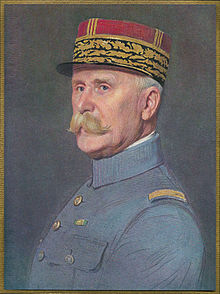
 Sometimes, when a war plane is in danger of being captured by the enemy, the pilot might take measures to destroy it, so that the technological secrets don’t end up in enemy hands. In fact, I believe that these days, anytime a plane goes down in enemy territory, the pilots are told to destroy them, but I’m not sure on that.
Sometimes, when a war plane is in danger of being captured by the enemy, the pilot might take measures to destroy it, so that the technological secrets don’t end up in enemy hands. In fact, I believe that these days, anytime a plane goes down in enemy territory, the pilots are told to destroy them, but I’m not sure on that.
Strange as that may seem to most of us, on November 27, 1942, something even more strange happened, but I’m getting ahead of myself. In June of 1940, after the German invasion of France and the establishment of an unoccupied zone in the southeast, which was led by General Philippe Petain, Admiral Jean Darlan was committed to keeping the French fleet out of German control. At the same time, as a minister in the government that had signed an armistice with the Germans, one that promised a relative “autonomy” to Vichy France, Darlan was prohibited from sailing that fleet to British or neutral waters. It put him in a rather precarious position, to say the least.
The British were as concerned as the French. A German-commandeered fleet in southern France, so close to British-controlled regions in North Africa, could prove disastrous to the British, who decided to take matters into their own hands by launching Operation Catapult…the attempt by a British naval force to persuade the French naval commander at Oran to either break the armistice and sail the French fleet out of the Germans’ grasp…or to scuttle it. And if the French wouldn’t, the Brits would. If you’ve ever heard the expression, “between a rock and a hard place,” you can picture this situation. And the British tried to push their way in it. In a five-minute missile bombardment, they managed to sink one French cruiser and two old battleships. They also killed 1,250 French sailors. This would be the source of much bad blood between France and England throughout the war. General Petain broke off diplomatic relations with Great Britain.
Two years later, the situation had worsened, with the Germans now in Vichy and the armistice already violated. Admiral Jean de Laborde finished the job the British had started. Just as the Germans launched Operation Lila…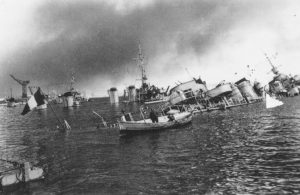
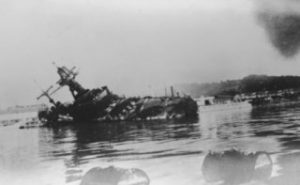 the attempt to commandeer the French fleet, at Toulon harbor, off the southern coast of France, Laborde ordered the sinking of 2 battle cruisers, 4 heavy cruisers, 2 light cruisers, 1 aircraft transport, 30 destroyers, and 16 submarines. Three French subs managed to escape the Germans and make it to Algiers, Allied territory. Only one sub fell into German hands. The marine equivalent of a scorched-earth policy had succeeded.
the attempt to commandeer the French fleet, at Toulon harbor, off the southern coast of France, Laborde ordered the sinking of 2 battle cruisers, 4 heavy cruisers, 2 light cruisers, 1 aircraft transport, 30 destroyers, and 16 submarines. Three French subs managed to escape the Germans and make it to Algiers, Allied territory. Only one sub fell into German hands. The marine equivalent of a scorched-earth policy had succeeded.
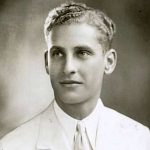 When a vicious killer is caught, sometimes the townspeople lose control of their emotions and take matters into their own hands. While it is a little less common these days, people would sometimes storm the jail to execute the prisoners themselves. Often it was thought that justice would not be served in the court system. People fear the possibility that the killer might get off and be back out in society again. These days, it is pretty hard to storm a jail, but jails weren’t as secure then, as they are now.
When a vicious killer is caught, sometimes the townspeople lose control of their emotions and take matters into their own hands. While it is a little less common these days, people would sometimes storm the jail to execute the prisoners themselves. Often it was thought that justice would not be served in the court system. People fear the possibility that the killer might get off and be back out in society again. These days, it is pretty hard to storm a jail, but jails weren’t as secure then, as they are now.
On November 9, 1933, Brooke Hart was abducted by two men in his own Studebaker. His family received a $40,000 ransom demand and, soon after, Hart’s wallet was found on a tanker ship in a nearby bay. The investigative trail led to John Holmes and Thomas Thurmond, who implicated each other in separate confessions. Both acknowledged, that Hart had been pistol-whipped and then thrown off the San Mateo Bridge. After Hart’s body 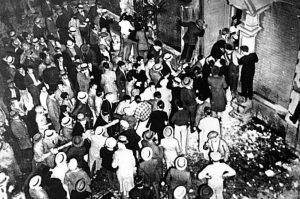 washed ashore on November 25, a vigilante mob began to form. Newspapers reported the possibility of a lynching and local radio stations broadcast the plan. Not only did Governor James Rolph reject the National Guard’s offer to send assistance, he reportedly said he would pardon those involved in the lynching. Now, when you have a governor who is on the side on the lynch mob, you have a volatile situation.
washed ashore on November 25, a vigilante mob began to form. Newspapers reported the possibility of a lynching and local radio stations broadcast the plan. Not only did Governor James Rolph reject the National Guard’s offer to send assistance, he reportedly said he would pardon those involved in the lynching. Now, when you have a governor who is on the side on the lynch mob, you have a volatile situation.
On November 26, 1933, thousands of people in San Jose, California, stormed the jail where Thomas Thurmond and John Holmes were being held. The angry mob converged at the jail and beat the guards, using a battering ram to break into the cells. Then, Thurmond and Holmes were dragged out and hanged from large trees in a nearby park. Contrary to the way most of us think, when our emotions aren’t raw, the public seemed to welcome the gruesome act of vigilante violence. After the incident, pieces of the lynching ropes were sold to 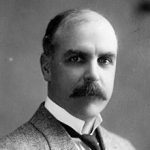 the public. Though the San Jose News declined to publish pictures of the lynching, it condoned the act in an editorial. Seventeen-year-old Anthony Cataldi bragged that he had been the leader of the mob but he was not held accountable for his participation. At Stanford University, a professor asked his students to stand and applaud the lynching. Perhaps most disturbing, Governor Rolph publicly praised the mob. “The best lesson ever given the country,” said Governor Rolph. “I would like to parole all kidnappers in San Quentin to the fine, patriotic citizens of San Jose.” I understand the anger, but not the method. While the two killers might have deserved the death penalty for their crimes, this was not the way it should have happened. Nevertheless, I guess justice was served…even if it was vigilante justice.
the public. Though the San Jose News declined to publish pictures of the lynching, it condoned the act in an editorial. Seventeen-year-old Anthony Cataldi bragged that he had been the leader of the mob but he was not held accountable for his participation. At Stanford University, a professor asked his students to stand and applaud the lynching. Perhaps most disturbing, Governor Rolph publicly praised the mob. “The best lesson ever given the country,” said Governor Rolph. “I would like to parole all kidnappers in San Quentin to the fine, patriotic citizens of San Jose.” I understand the anger, but not the method. While the two killers might have deserved the death penalty for their crimes, this was not the way it should have happened. Nevertheless, I guess justice was served…even if it was vigilante justice.
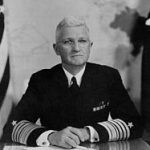
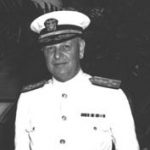 November 25, 1941, while not the date that would live in infamy, is a date that, in some ways, lives in infamy too. It was on this day that Admiral Harold R. Stark, United States Chief of Naval Operations, told Admiral Husband E. Kimmell, commander of the United States Pacific Fleet at Pearl Harbor, that both President Roosevelt and Secretary of State Cordell Hull thought that a Japanese surprise attack is a distinct possibility. It was their thought that the attack might possibly happen on the following Monday, because the Japanese were notorious for attacking without warning, President Franklin D. Roosevelt had informed his Cabinet. “We must all prepare for trouble, possibly soon,” he telegraphed British Prime Minister Winston Churchill.
November 25, 1941, while not the date that would live in infamy, is a date that, in some ways, lives in infamy too. It was on this day that Admiral Harold R. Stark, United States Chief of Naval Operations, told Admiral Husband E. Kimmell, commander of the United States Pacific Fleet at Pearl Harbor, that both President Roosevelt and Secretary of State Cordell Hull thought that a Japanese surprise attack is a distinct possibility. It was their thought that the attack might possibly happen on the following Monday, because the Japanese were notorious for attacking without warning, President Franklin D. Roosevelt had informed his Cabinet. “We must all prepare for trouble, possibly soon,” he telegraphed British Prime Minister Winston Churchill.
Kimmel’s command was at the mid-Pacific base at Oahu, which included, Pearl Harbor. At the time he received the “warning” from Stark, he was negotiating with Army Lieutenant General Walter C. Short, commander of all United States forces at Pearl Harbor, about sending United States warships out from Pearl Harbor in order to reinforce Wake and Midway Islands, along with the Philippines, which were considered possible Japanese targets. But the Army had no anti aircraft artillery to spare. War worries struck due to an intercepted Japanese diplomatic message, which gave November 25 as a deadline of sorts. If Japanese diplomacy had failed to convince the Americans to revoke the economic sanctions against Japan, “things will automatically begin to happen,” the message related. Those “things” were becoming obvious, in the form of Japanese troop movements off Formosa (Taiwan), toward Malaya. In reality, they were headed for Pearl Harbor, as was the Japanese First Air Fleet, but no one had guessed that was the intended target.
Despite the fact that so many in positions of command anticipated a Japanese attack, they had all failed to figure out that Hawaii was the target. When the attack came, they were all taken by complete and deadly surprise. Maybe they should have known, especially given the failure of diplomacy, when Japan refused United States demands to withdraw from both the Axis pact and occupied territories in China and Indochina, but no 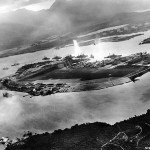
 one guessed Pearl Harbor was the target. Unfortunately they assumed Midway or Wake islands, because they seemed to be more strategic targets, and they expected that Japan would need those locations to have a chance at victory. I don’t know why the Japanese decided on Pearl Harbor, but perhaps it was a way of attacking in the heart of the United States…or as much as they felt they could. Whatever the case may be, the United States came back with a vengeance, and the Japanese would regret their attack on Pearl Harbor, because they would lose the war, date that would live in infamy…or not.
one guessed Pearl Harbor was the target. Unfortunately they assumed Midway or Wake islands, because they seemed to be more strategic targets, and they expected that Japan would need those locations to have a chance at victory. I don’t know why the Japanese decided on Pearl Harbor, but perhaps it was a way of attacking in the heart of the United States…or as much as they felt they could. Whatever the case may be, the United States came back with a vengeance, and the Japanese would regret their attack on Pearl Harbor, because they would lose the war, date that would live in infamy…or not.

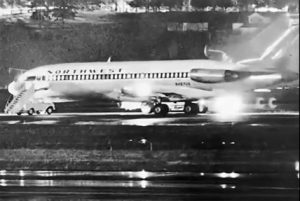 Airplane hijacking isn’t a new thing in our day and age, and usually the hijacker is extremely dangerous and often has plans to crash the plane, but there have been, in times past, some hijackings that weren’t “so bad” in the grand scheme of airplane hijacking, anyway. Sometimes the hijacker really just wanted to use the plane to get them where they wanted to go, planning to release the hostages upon arrival. Of course, hijacking isn’t really a good way to get to your vacation destination, or any other reason for your travel, because you are likely to get shot or arrested for your seemingly innocent attempts.
Airplane hijacking isn’t a new thing in our day and age, and usually the hijacker is extremely dangerous and often has plans to crash the plane, but there have been, in times past, some hijackings that weren’t “so bad” in the grand scheme of airplane hijacking, anyway. Sometimes the hijacker really just wanted to use the plane to get them where they wanted to go, planning to release the hostages upon arrival. Of course, hijacking isn’t really a good way to get to your vacation destination, or any other reason for your travel, because you are likely to get shot or arrested for your seemingly innocent attempts.
Nevertheless, on November 24, 1971, a hijacker calling himself D.B. Cooper commandeered a Northwest Orient Airlines 727 shortly after takeoff. He showed a flight attendant something that looked like a bomb, and informed the crew that he wanted $200,000, four parachutes, and “no funny stuff.” The plane landed at Seattle-Tacoma International Airport, where authorities met Cooper’s demands, which was common back then, and evacuated most of the passengers. Cooper then demanded that the plane fly toward Mexico at a low altitude and ordered the remaining crew members into the cockpit. At 8:13 pm, as the plane flew over the 
 Lewis River in southwest Washington, Cooper parachuted from the plane. The airplane’s pressure gauge recorded the jump. Wearing only wrap-around sunglasses, a thin suit, and a raincoat, Cooper parachuted into a thunderstorm, with winds in excess of 100 mph and temperatures well below zero at the 10,000 foot altitude where he began his fall. The storm prevented an immediate capture, and most authorities assumed he was killed during what they deemed a suicidal jump. No trace of Cooper has ever been found, despite a massive search of the area, and FBI posters, with age analysis.
Lewis River in southwest Washington, Cooper parachuted from the plane. The airplane’s pressure gauge recorded the jump. Wearing only wrap-around sunglasses, a thin suit, and a raincoat, Cooper parachuted into a thunderstorm, with winds in excess of 100 mph and temperatures well below zero at the 10,000 foot altitude where he began his fall. The storm prevented an immediate capture, and most authorities assumed he was killed during what they deemed a suicidal jump. No trace of Cooper has ever been found, despite a massive search of the area, and FBI posters, with age analysis.
In 1980, an eight year old boy uncovered a stack of nearly $5,880 of the ransom money in the sands along the north bank of the Columbia River, five miles from Vancouver, Washington. There was no trace of Cooper’s remains in the area. The money was given back to the boy, and he sold some of the bills as souvenirs. No more of the money has ever been found, on the ground or in circulation. More than four decades later, three amateur scientists working for a group called Citizen Sleuths, think they may have found evidence that would narrow down Cooper’s identity. They believe that he had to be an aerospace engineer or a manager. The scientists said they have been analyzing particles found on a clip-on necktie that Cooper left on his seat…number 18E…before 
 jumping out of the plane. To the naked eye, the piece of fabric was a nondescript black tie from J.C. Penney. But, to the modern-day scientists, the tie was an “incredibly fortunate” piece of evidence in the investigation, because ties are not washed often, so DNA could remain on the tie, and with modern DNA testing, maybe they will be able to figure out who D.B. Cooper really was.
jumping out of the plane. To the naked eye, the piece of fabric was a nondescript black tie from J.C. Penney. But, to the modern-day scientists, the tie was an “incredibly fortunate” piece of evidence in the investigation, because ties are not washed often, so DNA could remain on the tie, and with modern DNA testing, maybe they will be able to figure out who D.B. Cooper really was.

 All of my life, Thanksgiving was a time to spend the day with family, overeat Thanksgiving dinner, and relish the fact that I had the perfect family life. In my young years, everyone in my family was alive and well. The family was growing in one way or another, but until my grandfather, George Byer passed away in 1980, when I was 24 years old, I had never faced death in any way…never lost a loved one. I think it was then that I realized that things were never going to be the same again. Life would go forward, but there was no guarantee that each new year would find us celebrating with the same loved ones every year. Changes are inevitable, and loved ones going to heaven…it’s all a part of what is known as the circle of life. Still, it leaves me feeling more than a little bit lonely as the holidays, and life in general embark upon irreversible changes time after time.
All of my life, Thanksgiving was a time to spend the day with family, overeat Thanksgiving dinner, and relish the fact that I had the perfect family life. In my young years, everyone in my family was alive and well. The family was growing in one way or another, but until my grandfather, George Byer passed away in 1980, when I was 24 years old, I had never faced death in any way…never lost a loved one. I think it was then that I realized that things were never going to be the same again. Life would go forward, but there was no guarantee that each new year would find us celebrating with the same loved ones every year. Changes are inevitable, and loved ones going to heaven…it’s all a part of what is known as the circle of life. Still, it leaves me feeling more than a little bit lonely as the holidays, and life in general embark upon irreversible changes time after time.
The first years without your parents are always among the hardest. I never considered the possibility that I could one day be an orphan, and yet, I am. An orphan is, after all, someone whose parents have passed away. We usually think of an orphan as a child, but in reality, most people will become orphaned at some point in their lifetime…unless their parents outlive them. Anyway, I found myself an orphan, and the holidays…every day, in fact…have never been the same. The holiday gatherings are much smaller affairs, as my sisters and I 

 have redefined our holidays around our own families, as opposed to a large gathering of six families. While that is ok, and as it should be, there is still a small feeling of loneliness, because we don’t always see each other on the holidays now. Yes, we try to get together at least once before Christmas and a yearly picnic, just like my mom’s family has done, but the other holidays seem to have drifted into the category of small family gatherings, rather that large family gatherings. And, I have learned that in this life, you have no guarantee that your holidays will be the same from year to year, even if there is no loss in the family, because people also move away, and that changes the face of the holidays.
have redefined our holidays around our own families, as opposed to a large gathering of six families. While that is ok, and as it should be, there is still a small feeling of loneliness, because we don’t always see each other on the holidays now. Yes, we try to get together at least once before Christmas and a yearly picnic, just like my mom’s family has done, but the other holidays seem to have drifted into the category of small family gatherings, rather that large family gatherings. And, I have learned that in this life, you have no guarantee that your holidays will be the same from year to year, even if there is no loss in the family, because people also move away, and that changes the face of the holidays.
Still, Thanksgiving is a day to reflect on the things we have to be thankful for, and for me there are many. My daughters and their families are happy and well, and like my parents families did in the past, mine is growing, as my grandson, Chris Petersen and his fiancé, Karen Cruickshank are starting their own little family. We have 
 wonderful friends, my daughter Corrie Petersen’s in-laws, Becky and Duane Skelton, who have graciously included Bob and me into their Thanksgiving holiday, and we can go to my daughter, Amy Royce’s house for gatherings too, or they can come here, so the core of my perfect family is still in there, it’s just different now. While the years have changed the face of our family gatherings, I still have a great family life, and while I can’t call it the perfect family life anymore, because my parents are in Heaven, I can still call it a very blessed family life, and for that I am very thankful.
wonderful friends, my daughter Corrie Petersen’s in-laws, Becky and Duane Skelton, who have graciously included Bob and me into their Thanksgiving holiday, and we can go to my daughter, Amy Royce’s house for gatherings too, or they can come here, so the core of my perfect family is still in there, it’s just different now. While the years have changed the face of our family gatherings, I still have a great family life, and while I can’t call it the perfect family life anymore, because my parents are in Heaven, I can still call it a very blessed family life, and for that I am very thankful.
 My niece, Kelli Schulenberg is a lot like me when it comes to Winter’s cold…we don’t like it. It interferes with a lot of the things we want to do, like hiking, long beautiful nights, green trees and grass, and most of all…warmth. Winter is hard for a Summer girl. It’s almost like an invasion of privacy…blasting into your life, seemingly overnight, and while we usually have some warning…it really needs to be about ten years longer!!
My niece, Kelli Schulenberg is a lot like me when it comes to Winter’s cold…we don’t like it. It interferes with a lot of the things we want to do, like hiking, long beautiful nights, green trees and grass, and most of all…warmth. Winter is hard for a Summer girl. It’s almost like an invasion of privacy…blasting into your life, seemingly overnight, and while we usually have some warning…it really needs to be about ten years longer!!
Kelli is the type of person who really doesn’t like to have situations, circumstances, or  seasons to interfere with her plans. I think we can all relate to that. Hiking is difficult to do in the winter, so my plans get waylaid in the winter, but Kelli and her husband, Barry go snowshoeing, so I guess her plans aren’t quite as waylaid as mine. Nevertheless, things like icy roads are a huge nuisance. They make it hard to travel and everything takes longer. I think she and I would both just stay home in front of a fireplace with a nice cup of hot cocoa…if we could.
seasons to interfere with her plans. I think we can all relate to that. Hiking is difficult to do in the winter, so my plans get waylaid in the winter, but Kelli and her husband, Barry go snowshoeing, so I guess her plans aren’t quite as waylaid as mine. Nevertheless, things like icy roads are a huge nuisance. They make it hard to travel and everything takes longer. I think she and I would both just stay home in front of a fireplace with a nice cup of hot cocoa…if we could.
Kelli loves music and concerts…Country music, of course…although she might like some of the other genres too. She and Barry often travel to go to different concerts, which is nice, because it lets them see the sights along the way too. Their concert tours have taken them to lots of great places, and with the concerts, they had something fun to 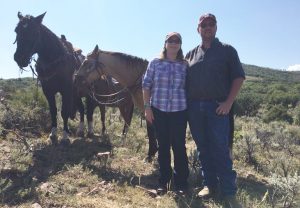 do during the trip.
do during the trip.
Kelli and Barry have hiked in a number of places, including Casper Mountain, of course. Kelli’s mom, Mary Wages runs a campground in Colorado, so they go see her and get some hiking in there too, but wherever Kelli and Barry travel, they try to find a trail to hike on. Hiking is such a great pastime, because you get to see places that you just can’t see from a car. You are out in nature and the fresh air, and sometimes you even get to see some amazing wildlife…when they aren’t hiding from you that is. Today is Kelli’s birthday Happy birthday Kelli!! Have a great day!! We love you!!
 Every November 22nd brings unimaginable sadness to members of the Spethman family, as well as the rest of our family, as we remember the baby most of us never got to meet. Laila Elizabeth Spethman was just 18 days old when she went to Heaven, leaving behind her a family wishing that things could have been different. There are never any easy answers for why a child dies, only questions. The biggest question is, “Why did this happen to us?” Of course, there is no answer. Things like the loss of a child don’t go after certain families. Death is not vindictive…it’s just painful. It just leaves us feeling empty…just horribly, and irreversibly empty.
Every November 22nd brings unimaginable sadness to members of the Spethman family, as well as the rest of our family, as we remember the baby most of us never got to meet. Laila Elizabeth Spethman was just 18 days old when she went to Heaven, leaving behind her a family wishing that things could have been different. There are never any easy answers for why a child dies, only questions. The biggest question is, “Why did this happen to us?” Of course, there is no answer. Things like the loss of a child don’t go after certain families. Death is not vindictive…it’s just painful. It just leaves us feeling empty…just horribly, and irreversibly empty. 
That’s what Laila left behind, when she went to Heaven…emptiness. There is an empty spot in the family, where she should be…six years between her big brother, Isaac and her little sister, Aleesia. And empty chair at the table that Laila never got to sit in. And empty spot in the first grade, where she should be learning. There is an empty spot for Aleesia, who will never have a sister, and empty spot for Xander, Zack, and Isaac because they knew her for those days, knew that they were supposed to have a little sister named Laila, and then they didn’t. And there is an empty spot for her parents, Jenny and Steve,  who have had the feeling of empty arms since that awful day…they have a daughter named Laila, but they can’t hold her, raise her, or know her. But all they have in emptiness where Laila is concerned. It is an emptiness we all feel.
who have had the feeling of empty arms since that awful day…they have a daughter named Laila, but they can’t hold her, raise her, or know her. But all they have in emptiness where Laila is concerned. It is an emptiness we all feel.
Yes, Jenny and Steve have four beautiful, happy children, but that can never fill the emptiness that the lost one left. That’s because each child is their own person. They are not interchangeable. One cannot replace another. While each of their children is a joy in their own right, they are never going to be able to fill that one empty spot…the one Laila left behind. We will always love and miss you Laila Elizabeth Spethman, and we will see you again someday in Heaven.

 For years we have been told that you can find out a lot about a person by their non-verbal communication…body language. Basically it is their physical behavior in any situation, as opposed to what they say about it. Things like facial expressions, body posture, gestures, eye movement, touch, and the use of space are key ways to tell if someone is lying, angry, or excited. Body language exists in both animals and humans, and anyone who has come up on a mother bear or a moose, can tell you. Believe me, I hope that none of my readers have found themselves in that situation.
For years we have been told that you can find out a lot about a person by their non-verbal communication…body language. Basically it is their physical behavior in any situation, as opposed to what they say about it. Things like facial expressions, body posture, gestures, eye movement, touch, and the use of space are key ways to tell if someone is lying, angry, or excited. Body language exists in both animals and humans, and anyone who has come up on a mother bear or a moose, can tell you. Believe me, I hope that none of my readers have found themselves in that situation.
I have always been told things like…when you are being interviewed, don’t cross your arms, because it makes you seem closed off, as well as, that it is a nervous habit to play with your hair, but I happen to know that things aren’t always so cut and dried. Anyone who knows me knows that if my arms are crossed over my body…I’m cold. And if I am playing with my hair, it isn’t because I’m nervous, but rather it is just something I like the feel of. Basically, I think that while body language is an effective tool. it isn’t the only way, and sometimes not even the best way to read a person. Body language isn’t a spoken language, and so must be interpreted broadly, instead of having an absolute meaning corresponding with a certain movement, which explains why my movements can be misleading.
Body language is even more difficult, in that, interpretations can vary from country to country, or culture to  culture. Some experts aren’t even sure that body language is universal. Body language is a subset of nonverbal communication, and really complements verbal communication in social interaction. Just think of how often you find people who can’t tell a story without using their hands…and their hands aren’t even saying anything specific. They are simply a gesture designed to clarify the story. Some researchers would say that nonverbal communication accounts for the majority of information transmitted during interpersonal interactions. It helps to establish the relationship between two people and regulates interaction, but beware, because it can be ambiguous, as seen in my own crossed arms not indicating being closed off, but rather cold. Facial expression is extremely important when expressing emotions through the body. If the body is saying one thing, and the face is saying another, maybe the person has something to hide, or the story they are telling is a lie. Combinations of eyes, eyebrow, lips, nose, and cheek movements help form different moods of an individual.
culture. Some experts aren’t even sure that body language is universal. Body language is a subset of nonverbal communication, and really complements verbal communication in social interaction. Just think of how often you find people who can’t tell a story without using their hands…and their hands aren’t even saying anything specific. They are simply a gesture designed to clarify the story. Some researchers would say that nonverbal communication accounts for the majority of information transmitted during interpersonal interactions. It helps to establish the relationship between two people and regulates interaction, but beware, because it can be ambiguous, as seen in my own crossed arms not indicating being closed off, but rather cold. Facial expression is extremely important when expressing emotions through the body. If the body is saying one thing, and the face is saying another, maybe the person has something to hide, or the story they are telling is a lie. Combinations of eyes, eyebrow, lips, nose, and cheek movements help form different moods of an individual.
Some studies show that to really interpret emotions, both facial expression and bodily language must be taken into account. Behavioral experiments have also shown that “recognition of facial expression is influenced by perceived bodily expression. This means that the brain processes the other’s facial and bodily expressions simultaneously.” Participants in these studies were accurately able to judge emotions based on facial expression. This is because the face and the body are normally seen together in their natural proportions and the emotional signals from the face and body are well integrated. Things like a lack of crinkles around the eyes would suggest a fake smile. At one point, researchers believed that making a genuine smile was nearly impossible to do on command. I hadn’t thought about that, but it makes sense. When you’re smiling joyfully, 
 they crinkle. When you’re faking it, they don’t. If someone’s trying to look happy but isn’t, you won’t see wrinkles.
they crinkle. When you’re faking it, they don’t. If someone’s trying to look happy but isn’t, you won’t see wrinkles.
I find it quite interesting to study the different interpretations that have been place in body language, and I think that many of them are probably pretty close to accurate, but it’s always a good idea to keep an open mind when it comes to body language. When we are too quick to make a judgment, we can find ourselves realizing that we were completely in the wrong in our interpretation of non-verbal communication.
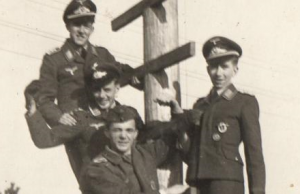 New York City…a place as glamorous as any city in the world, the financial center of the world…and a target. Most of us know about the attacks on the World Trade Center in 1993, and again on September 11, 2001, but there was another attack that was planned for New York City, and in the end…foiled. This attack is most likely one you don’t recall…in fact, I think very few people even knew about it. The United States has enemies, as most nations do, and one of the best know enemies of the United States was Adolf Hitler.
New York City…a place as glamorous as any city in the world, the financial center of the world…and a target. Most of us know about the attacks on the World Trade Center in 1993, and again on September 11, 2001, but there was another attack that was planned for New York City, and in the end…foiled. This attack is most likely one you don’t recall…in fact, I think very few people even knew about it. The United States has enemies, as most nations do, and one of the best know enemies of the United States was Adolf Hitler.
According to an article I read recently, two men. Laureano Clavero and Pere Cardona, interviewed a Nazi pilot from World War II, who passed away in 2013. According to their research and their interview, the two claimed that they had proven the planned attack was real in an interview as they promoted their new book, The Diary of Peter Brill, a Nazi pilot during World War Two. In the interview, Peter Brill, who has been dubbed The Last Luftwaffe Pilot, claimed that Hitler was developing a plan to send a huge bomber from Germany to the United States. The New York mission has long been considered a myth, but Clavero and Cardona insist Brill admitted his involvement when they interviewed him. They claimed that Brill was a part of the secret project.

Clavero came across Brill and his history in 2010, when he was investigating the crash of two German bombers in the Pyrenees during the conflict. I’m always amazed at how often looking for one piece of information leads to another discovery. Brill agreed to give the authors an interview, and told them that he had been asked to take part in a secret mission to cross the Atlantic and launch the huge bombardment. While Brill was not specific, the two authors believe the project was convened in 1943, with Hitler’s enthusiastic support. The huge Heinkel plane was to be modified to allow it to fly 12,000 miles…the distance from Berlin to New York and back.
Brill and five others received top-secret training in the Polish city of Thorn, where they learned to fly at high altitude. They had to brave the frequent fires in the bomber’s engines. Before long, it became clear that the Heinkel was incapable of flying to New York and back. The authors claim that, when it became clear that the “Junker” could not fly such a long distance, the German engineers toyed with various workarounds, including  the creation of a halfway house and the coupling of the bomber to a Mescherschmitt. Nevertheless, it soon became clear to everyone that the mission would have to be scrapped, as there were more pressing difficulties taking precedence. “What is certain is that they were close to realizing their objective, but all the crazy dreams of Hitler were left to one side after the battle of Stalingrad,” Cardona said. “They were pushed aside for the day-to-day problems.” Clavero and Cardona have written their new book using the interviews given by Brill, and the memoirs gifted to them by his family when he died. The book sounds very interesting, and I, for one, plan to read about this…almost attack on New York City.
the creation of a halfway house and the coupling of the bomber to a Mescherschmitt. Nevertheless, it soon became clear to everyone that the mission would have to be scrapped, as there were more pressing difficulties taking precedence. “What is certain is that they were close to realizing their objective, but all the crazy dreams of Hitler were left to one side after the battle of Stalingrad,” Cardona said. “They were pushed aside for the day-to-day problems.” Clavero and Cardona have written their new book using the interviews given by Brill, and the memoirs gifted to them by his family when he died. The book sounds very interesting, and I, for one, plan to read about this…almost attack on New York City.
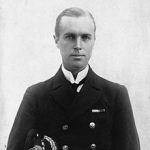 During World War I, airplanes were just in their infancy. The senior officers on all sides doubted the usefulness of “air machines” in warfare. Of course, history tells us that they were very wrong…in more ways than one. Of course, war planes have been winning battles for over a hundred years, but planes can do so much more, and in more areas than just wars, but that’s another story. This story is about how “air machines” changed the face of World War I. Of course, the planes did things like spying on the enemy and the same things we all would expect for planes and their pilots, but one pilot made a daring rescue that would be one for the history books.
During World War I, airplanes were just in their infancy. The senior officers on all sides doubted the usefulness of “air machines” in warfare. Of course, history tells us that they were very wrong…in more ways than one. Of course, war planes have been winning battles for over a hundred years, but planes can do so much more, and in more areas than just wars, but that’s another story. This story is about how “air machines” changed the face of World War I. Of course, the planes did things like spying on the enemy and the same things we all would expect for planes and their pilots, but one pilot made a daring rescue that would be one for the history books.
In the early days of the war, Squadron Commander Richard Bell Davies and Flight Lieutenant Richard Peirse carried out a number of raids on German submarine bases at Ostend and Zeebrugge. Both were awarded the Distinguished Service Order for services rendered in the aerial attack on Dunkirk on January 23, 1915. These men repeatedly attacked the German submarine station at Ostend and Zeebrugge, being subjected on each occasion to heavy and accurate fire, their machines being frequently hit. In particular, on January 23rd, they each discharged eight bombs in an attack upon submarines alongside the mole at Zeebrugge, flying down to close range. At the outset of this flight, Lieutenant Davies was 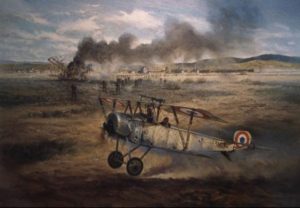 severely wounded by a bullet in the thigh, but nevertheless he accomplished his task, handling his machine for an hour with great skill in spite of pain and loss of blood. But this would not be the mission he was most remembered for.
severely wounded by a bullet in the thigh, but nevertheless he accomplished his task, handling his machine for an hour with great skill in spite of pain and loss of blood. But this would not be the mission he was most remembered for.
On November 19, 1915, Richard Bell Davies showed his true worth when, in one of the most exciting episodes of the air war during World War I, he performed a daring rescue. As squadron commander in the Royal Naval Air Service, Davies was flying alongside Flight Sub-Lieutenant Gilbert F Smylie on a bombing mission. Their target for the day was the railway junction at Ferrijik, located near the Aegean Sea and the border between Bulgaria and Ottoman-controlled Europe. Suddenly, Smylie’s plane was hit by Turkish anti-aircraft fire, and he was forced to land. As he made his way to the ground, Smylie was able to release all his bombs but one before making a safe landing behind enemy lines. Smylie was then unable to restart his plane and immediately set fire to the aircraft in order to disable it.
Davies observed his comrade’s situation from the air and quickly moved to land his own plane nearby. Seeing Davies coming to his rescue and fearing the remaining bomb on his plane would explode, injuring or killing 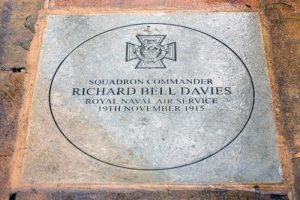 them both, Smylie quickly took aim at his machine with his revolver and fired, exploding the bomb safely just before Davies came within its reach. Davies then rushed to grab hold of Smylie, hauling him on board his aircraft just as a group of Turkish soldiers approached. Before the Turks could reach them, Davies took off, flying himself and Smylie to safety behind British lines. The British government awarded him the Victoria Cross on January 1, 1916, for what they called a “feat of airmanship that can seldom have been equaled for skill and gallantry.” For Smylie, it was a daring rescue that he could never thank his commander enough for. The quick-thinking Smylie was rewarded as well. He received the Distinguished Service Cross.
them both, Smylie quickly took aim at his machine with his revolver and fired, exploding the bomb safely just before Davies came within its reach. Davies then rushed to grab hold of Smylie, hauling him on board his aircraft just as a group of Turkish soldiers approached. Before the Turks could reach them, Davies took off, flying himself and Smylie to safety behind British lines. The British government awarded him the Victoria Cross on January 1, 1916, for what they called a “feat of airmanship that can seldom have been equaled for skill and gallantry.” For Smylie, it was a daring rescue that he could never thank his commander enough for. The quick-thinking Smylie was rewarded as well. He received the Distinguished Service Cross.

